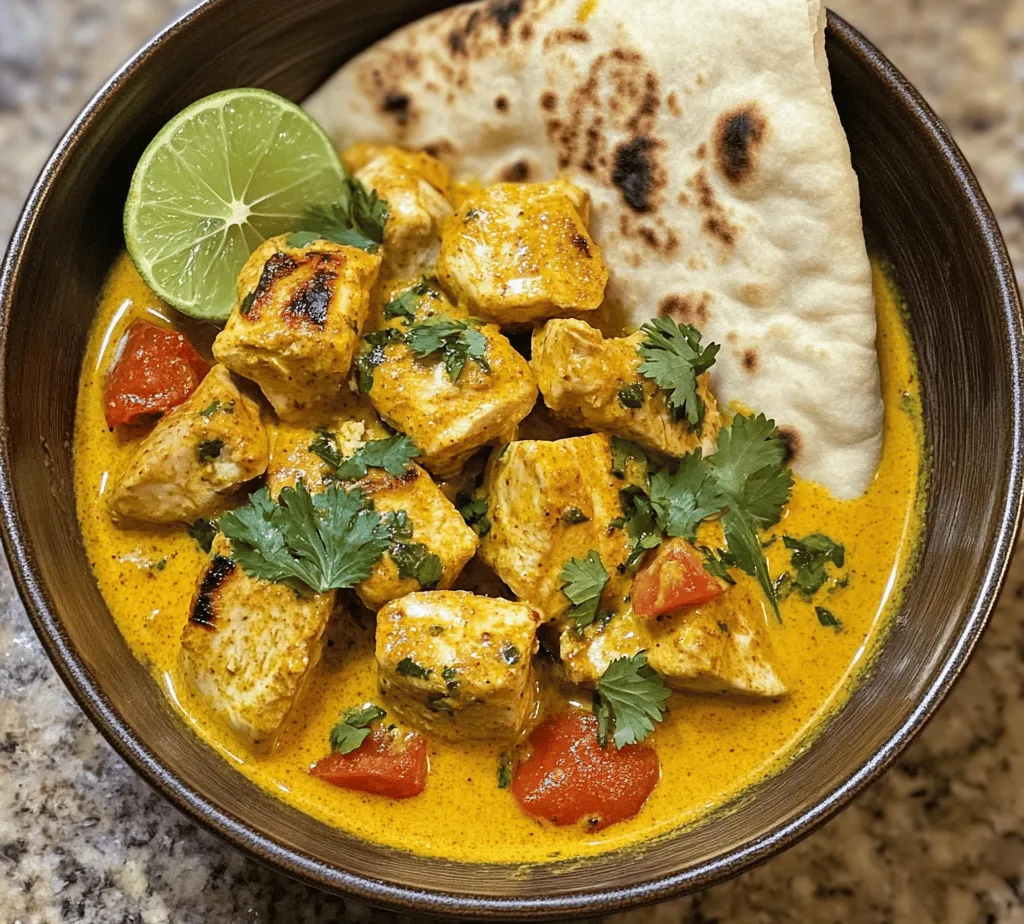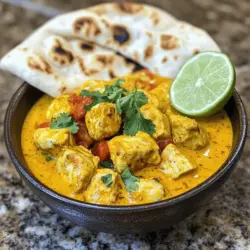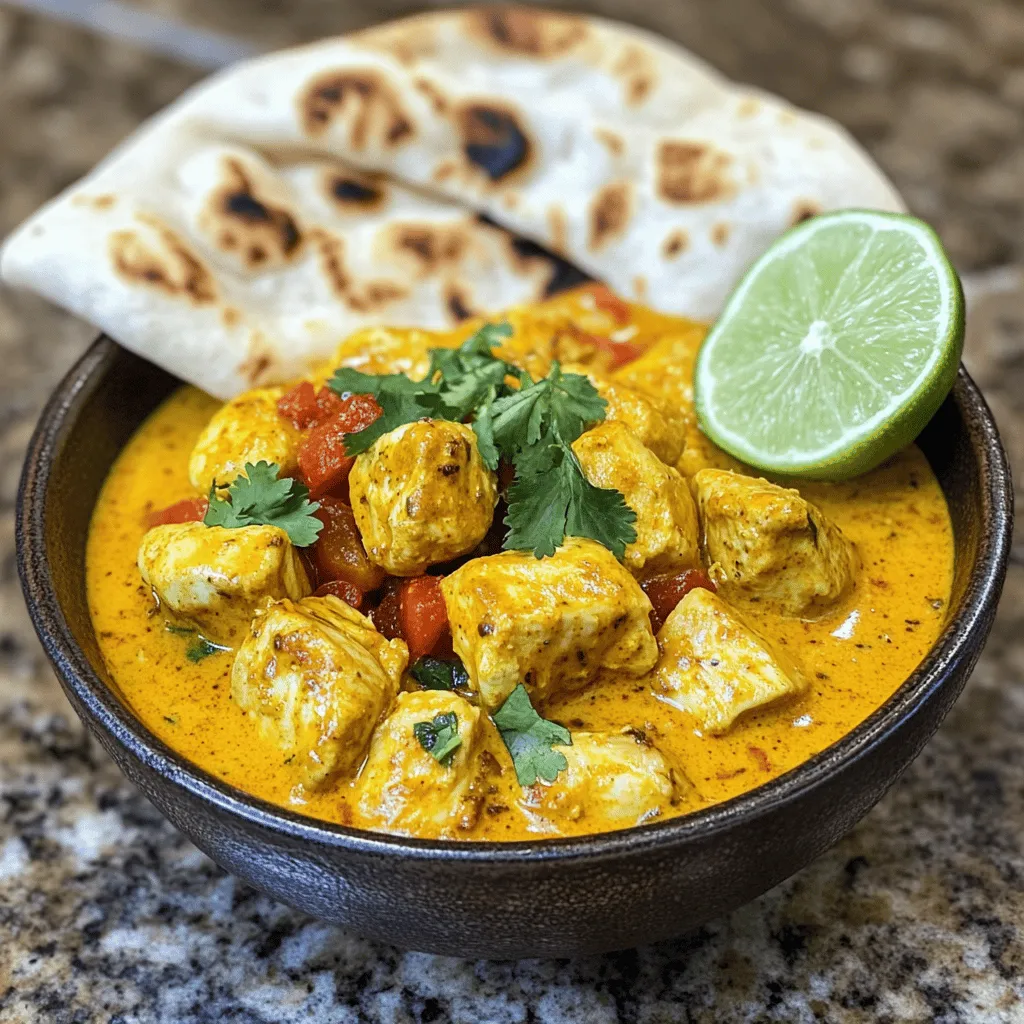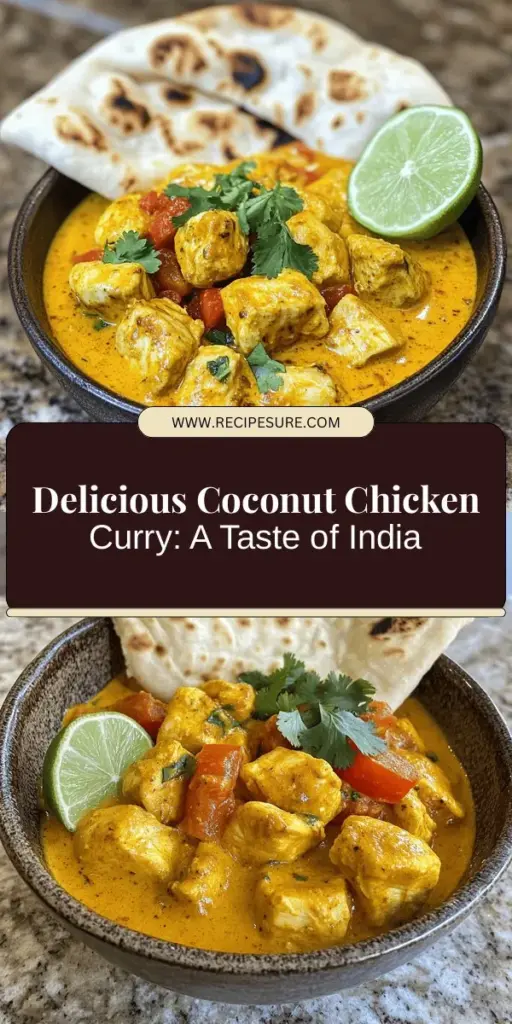Introduction
Indian cuisine is a vibrant tapestry of flavors, colors, and aromas that has captivated food lovers around the globe. Its rich history and diverse regional influences contribute to a culinary landscape that offers something for every palate. From spicy curries to fragrant biryanis, Indian food is known for its unique ability to blend various spices and ingredients in ways that create unforgettable meals. Among the myriad of dishes that showcase this culinary artistry, Coconut Chicken Curry stands out as a beloved favorite that brings together the warmth of spices and the creaminess of coconut milk.
Coconut Chicken Curry is a delightful dish that hails from the coastal regions of India, where coconuts flourish and are a staple ingredient. This dish not only embodies the essence of Indian cooking but also highlights the harmonious interplay of flavors that make it a comforting and satisfying meal. The combination of tender chicken simmered in a rich, coconut-infused sauce, accentuated with a medley of spices, creates a unique taste that is both complex and approachable. It’s a dish that can be enjoyed on special occasions or as a comforting weeknight dinner, making it a versatile addition to any home cook’s repertoire.
Understanding Coconut Chicken Curry
Coconut Chicken Curry finds its roots in the southern coastal regions of India, particularly in states like Kerala and Tamil Nadu. These areas are known for their lush landscapes and abundant coconut groves, which have significantly influenced local cuisine. The use of coconut milk in cooking is deeply ingrained in the culinary traditions of these regions, providing a creamy texture and a hint of sweetness that complements the bold spices commonly used in Indian dishes.
The cultural significance of Coconut Chicken Curry extends beyond its delicious taste. It is often prepared during family gatherings, celebrations, and festivals, symbolizing hospitality and warmth. This dish showcases the communal spirit of Indian cooking, where families come together to share meals and create lasting memories.
Coconut itself is a powerhouse of nutrition, offering numerous health benefits. Rich in medium-chain triglycerides (MCTs), coconut milk can provide a quick source of energy while promoting heart health. Furthermore, the spices used in this curry—such as turmeric, coriander, and chili—are known for their anti-inflammatory and antioxidant properties, making this dish not just flavorful but also a nutritious option.
Ingredients Breakdown
To create the perfect Coconut Chicken Curry, it’s essential to understand the role of each ingredient. Here’s a detailed breakdown of the ingredients that come together to form this delicious dish:
Chicken Breast
At the heart of this Coconut Chicken Curry is the chicken breast, a lean source of protein that absorbs flavors beautifully. Chicken breast is preferred for its tenderness and quick cooking time, making it an ideal choice for a dish that is both flavorful and easy to prepare. It provides the necessary protein to balance the meal and complements the creamy coconut sauce perfectly.
Coconut Milk
Coconut milk is the star ingredient in this curry, bringing a rich creaminess and a touch of sweetness that enhances the overall flavor profile. This ingredient not only adds depth to the dish but also creates a luscious sauce that clings to the chicken, making every bite satisfying. It’s important to use high-quality coconut milk for the best results, as it contributes significantly to the dish’s character.
Spices
- Curry Powder: A quintessential component of Indian cooking, curry powder is a blend of spices that provides a warm and aromatic base for the curry. It typically includes turmeric, coriander, cumin, and fenugreek, each contributing to the dish’s complexity.
- Ground Coriander: Known for its citrusy undertones, ground coriander adds a fresh, herbal note to the curry. It’s also packed with nutrients and is believed to aid in digestion.
- Turmeric: This vibrant yellow spice not only imparts a beautiful color to the dish but is also renowned for its anti-inflammatory properties. Turmeric brings an earthy flavor that complements the other spices.
- Garam Masala: A traditional Indian spice blend that varies by region, garam masala is typically made from a combination of spices like cardamom, cloves, and cinnamon. It adds warmth and a fragrant aroma, elevating the overall flavor of the curry.
- Red Chili Powder: Adjusting the spice level to personal preference is easy with red chili powder. It adds heat and a vibrant red hue to the dish, making it visually appealing.
Fresh Ingredients
The base of the curry is built using fresh ingredients that contribute essential flavors:
- Onion: Sautéed until golden, onions provide a sweet and savory foundation for the curry.
- Garlic: Known for its pungent flavor, garlic enhances the dish’s aroma and is a common staple in Indian kitchens.
- Ginger: Fresh ginger adds a zesty kick, balancing the richness of coconut milk with its bright flavor.
- Tomatoes: Adding acidity and sweetness, tomatoes help to create a balanced sauce that enhances the chicken’s flavor.
Optional Ingredients
For those looking to boost nutrition and flavor further, consider adding spinach and a splash of lime juice:
- Spinach: This leafy green is packed with vitamins and minerals, and it wilts beautifully into the curry, adding a pop of color and nutrition.
- Lime Juice: A squeeze of fresh lime juice at the end brightens the dish, enhancing the flavors and adding a refreshing tang.
Preparation Steps
Now that we have a clear understanding of the ingredients and their purpose, let’s dive into the step-by-step preparation of Coconut Chicken Curry. This straightforward guide will help you create a dish that’s bursting with flavor and aromatic goodness.
Step 1: Sauté the Base
Begin by heating a few tablespoons of oil in a large skillet or pot over medium heat. Once the oil is hot, add finely chopped onions. Sauté the onions until they turn golden brown, stirring occasionally to prevent burning. This process is crucial, as caramelized onions add sweetness and depth to the curry.
Next, introduce minced garlic and grated ginger to the pan. Sauté them for about one minute until fragrant, being careful not to allow them to brown too much; this can lead to bitterness. The combination of onions, garlic, and ginger creates a flavorful base that is essential for any good curry.
Step 2: Incorporate the Spices
Once the onion mixture is ready, it’s time to incorporate the spices. Add the curry powder, ground coriander, turmeric, garam masala, and red chili powder to the pan. Stir the spices into the oil and cook for another minute, allowing the spices to toast slightly. This step is vital, as it helps release their essential oils, intensifying their flavors and aromas.
Next, add chopped tomatoes to the mixture. The acidity from the tomatoes will help deglaze the pan, lifting any flavorful bits stuck to the bottom and enriching the sauce. Cook until the tomatoes soften and break down, creating a thick, aromatic paste.
Step 3: Add the Chicken and Coconut Milk
With the spice base ready, it’s time to add the chicken breast. Cut the chicken into bite-sized pieces to ensure even cooking and maximum flavor absorption. Stir the chicken into the mixture, coating it well with the spices and onion-tomato base. Cook for several minutes until the chicken is no longer pink.
Finally, pour in the coconut milk, stirring to combine everything. The creamy coconut milk will turn the mixture into a luscious sauce, enveloping the chicken in a rich, flavorful bath. Bring the curry to a gentle simmer, allowing the flavors to meld together beautifully.
As the dish simmers, you can take this opportunity to taste and adjust the seasoning, adding salt to enhance the flavors and red chili powder for an extra kick, if desired.
With these initial steps complete, you are well on your way to creating a delicious Indian Coconut Chicken Curry that will impress family and friends alike. Stay tuned for the following sections, where we will delve deeper into finishing touches, serving suggestions, and tips for perfecting this beloved dish.

Cooking Chicken: Ensuring It’s Tender and Flavorful
To achieve the perfect Indian Coconut Chicken Curry, the first step is to ensure your chicken is tender and flavorful. Begin by marinating the chicken pieces in a mix of yogurt, turmeric, and salt for at least 30 minutes, preferably a few hours. This not only infuses the chicken with flavors but also helps to tenderize it. When you’re ready to cook, heat oil in a large pot over medium heat. Add the marinated chicken, cooking it until it’s browned on all sides. This browning process seals in the juices, ensuring a juicy and delicious result. Avoid overcrowding the pan, as this can cause the chicken to steam rather than sear. Cook the chicken in batches if necessary, removing it from the pot and setting it aside while you prepare the sauce.
Adding Tomato Puree and Coconut Milk: Creating the Sauce’s Foundation
Once the chicken is beautifully browned, it’s time to create the sauce that will elevate your curry. In the same pot, add finely chopped onions and sauté them until they turn golden brown. Then, incorporate minced garlic and ginger, stirring until fragrant. Next, pour in tomato puree, a key ingredient that provides acidity and depth of flavor. Allow the mixture to simmer for a few minutes, letting the tomatoes break down and meld with the aromatics.
After the tomato base has cooked down, add coconut milk to the pot. This creamy ingredient is essential for achieving the rich, velvety texture that Indian Coconut Chicken Curry is known for. The combination of tomato and coconut creates a harmonious balance of sweetness and tanginess that complements the spices beautifully. Stir well to combine all the ingredients, ensuring the chicken is coated in this luscious sauce.
Simmering: The Significance of Cooking Time for Flavor Development
Simmering is a crucial step in developing the flavors of your curry. After adding the chicken back to the pot, cover it and lower the heat to a gentle simmer. Allow the curry to cook for at least 20-30 minutes. During this time, the chicken will absorb the flavors from the sauce, becoming tender and delicious. The longer you simmer, the more the spices will integrate, creating a complex and satisfying dish. Stir occasionally to prevent sticking and ensure even cooking. If the sauce thickens too much, add a splash of water or extra coconut milk to maintain the desired consistency.
Final Touches: How Lime Juice and Cilantro Enhance the Dish
As your curry reaches its final stages, don’t forget the finishing touches that will elevate its flavor profile. Just before serving, squeeze fresh lime juice over the curry. The acidity from the lime will brighten the dish, cutting through the richness of the coconut milk and enhancing the overall flavor.
Additionally, sprinkle chopped fresh cilantro over the top. This herb adds a burst of freshness and a pop of color to your Coconut Chicken Curry. Not only does cilantro enhance the visual appeal, but it also contributes a unique flavor that complements the spices beautifully. Stir these final ingredients into your curry, and your dish is ready to be served!
Serving Suggestions
Best Side Dishes to Accompany Coconut Chicken Curry
Coconut Chicken Curry is a versatile dish that pairs well with a variety of side dishes. Traditional accompaniments include:
- Steamed Rice: Basmati rice is a classic choice. Its fluffy texture absorbs the curry sauce beautifully, making each bite more enjoyable.
- Naan Bread: Soft, warm naan is perfect for scooping up the curry. You can opt for plain naan or explore garlic or butter naan for added flavor.
Suggestions for Pairing with Salads or Chutneys
For a well-rounded meal, consider adding a fresh salad or a side of chutney:
- Cucumber Raita: This yogurt-based salad cools down the palate and pairs perfectly with the spiciness of the curry.
- Mango Chutney: The sweetness of mango chutney complements the spices and richness of the curry, creating a delightful contrast.
Presentation Tips for a Visually Appealing Meal
Presentation can elevate your dining experience. Serve your Coconut Chicken Curry in a beautiful bowl, garnished with fresh cilantro and lime wedges. For a pop of color, consider adding a side of bright, fresh salad or a vibrant chutney. Arranging your dishes on a large platter can also create an inviting and communal dining experience.
Nutritional Information
Breakdown of Nutritional Values per Serving
A serving of Coconut Chicken Curry (approximately one cup) typically contains the following nutritional values:
- Calories: 400-500 kcal
- Protein: 25-30g
- Carbohydrates: 20-25g
- Fat: 30-35g
- Fiber: 2-3g
Discussion of Health Benefits of Key Ingredients
Coconut milk is rich in medium-chain triglycerides (MCTs), which are beneficial fats that may support weight management and provide quick energy. The spices used in the curry, such as turmeric and ginger, are known for their anti-inflammatory properties and potential health benefits. Turmeric contains curcumin, which may help fight inflammation and support overall health.
Considerations for Dietary Restrictions and Modifications
This recipe can be easily modified for various dietary needs. For a vegetarian version, substitute chicken with chickpeas or tofu. You can also use low-fat coconut milk or a dairy-free yogurt alternative for a lighter dish. Be mindful of the spice levels; adjust the number of chilies or omit them entirely for a milder flavor, making it suitable for sensitive palates.
Cooking Tips for Success
Advice on Ingredient Substitutions for Different Dietary Needs
If you’re looking to make this dish more heart-healthy, consider using skinless chicken thighs instead of breasts. For a vegetarian option, replace the chicken with cauliflower or lentils, which will absorb the curry flavors well.
Tips for Adjusting Spice Levels to Cater to Different Palates
To customize the spice level, start with a smaller amount of chili powder or fresh chilies, and gradually increase to taste. If you accidentally make the curry too spicy, adding a bit more coconut milk or a dollop of yogurt can help mellow the heat.
Recommendations for Meal Prep and Storage for Leftovers
Coconut Chicken Curry is perfect for meal prep. Store leftovers in an airtight container in the refrigerator for up to three days. The flavors tend to deepen after a day, making it even more delicious. For longer storage, freeze the curry in portions. When ready to enjoy, simply thaw and reheat on the stovetop, adding a bit of coconut milk or water to restore consistency.
Cultural Variations
Overview of Different Regional Variations of Coconut Chicken Curry Across India
Coconut Chicken Curry has numerous regional variations throughout India, each with its own unique spin on the dish. In Southern India, particularly in Kerala, the curry is often made with freshly grated coconut and a medley of spices, resulting in a more pronounced coconut flavor. In contrast, Northern Indian versions may incorporate richer, creamier sauces with an emphasis on spices like garam masala, highlighting the diversity of flavors across the country.
Discussion on How Local Ingredients Influence Flavor and Preparation Methods
The use of local ingredients significantly influences the flavor profile of Coconut Chicken Curry. For instance, coastal regions of India often utilize fresh seafood and local spices, while inland areas may rely more on poultry and distinct spice blends. These regional adaptations create a tapestry of flavors, showcasing the vast culinary heritage of India.
Insights into Family Traditions and How Recipes Are Passed Down Through Generations
Many families have their own cherished versions of Coconut Chicken Curry, passed down through generations. These recipes often carry stories of family gatherings and special occasions. Cooking together fosters a sense of community and connection, making each meal a celebration of heritage and tradition.
Conclusion
Coconut Chicken Curry is not just a dish; it represents the heart and soul of Indian cuisine. Its rich flavors, vibrant colors, and comforting nature make it a beloved choice for many. Exploring this recipe in your kitchen allows you to connect with the traditions and stories behind it, creating an opportunity to share a delightful meal with family and friends.
As you venture to make this dish, don’t hesitate to experiment with the ingredients and spices. Cooking is an art, and every dish is an opportunity to express creativity. Embrace the communal aspect of dining, and enjoy the joy that comes from sharing a meal with loved ones. The kitchen is a space for love, laughter, and connection, and your Indian Coconut Chicken Curry will surely be a highlight of your culinary adventures.


